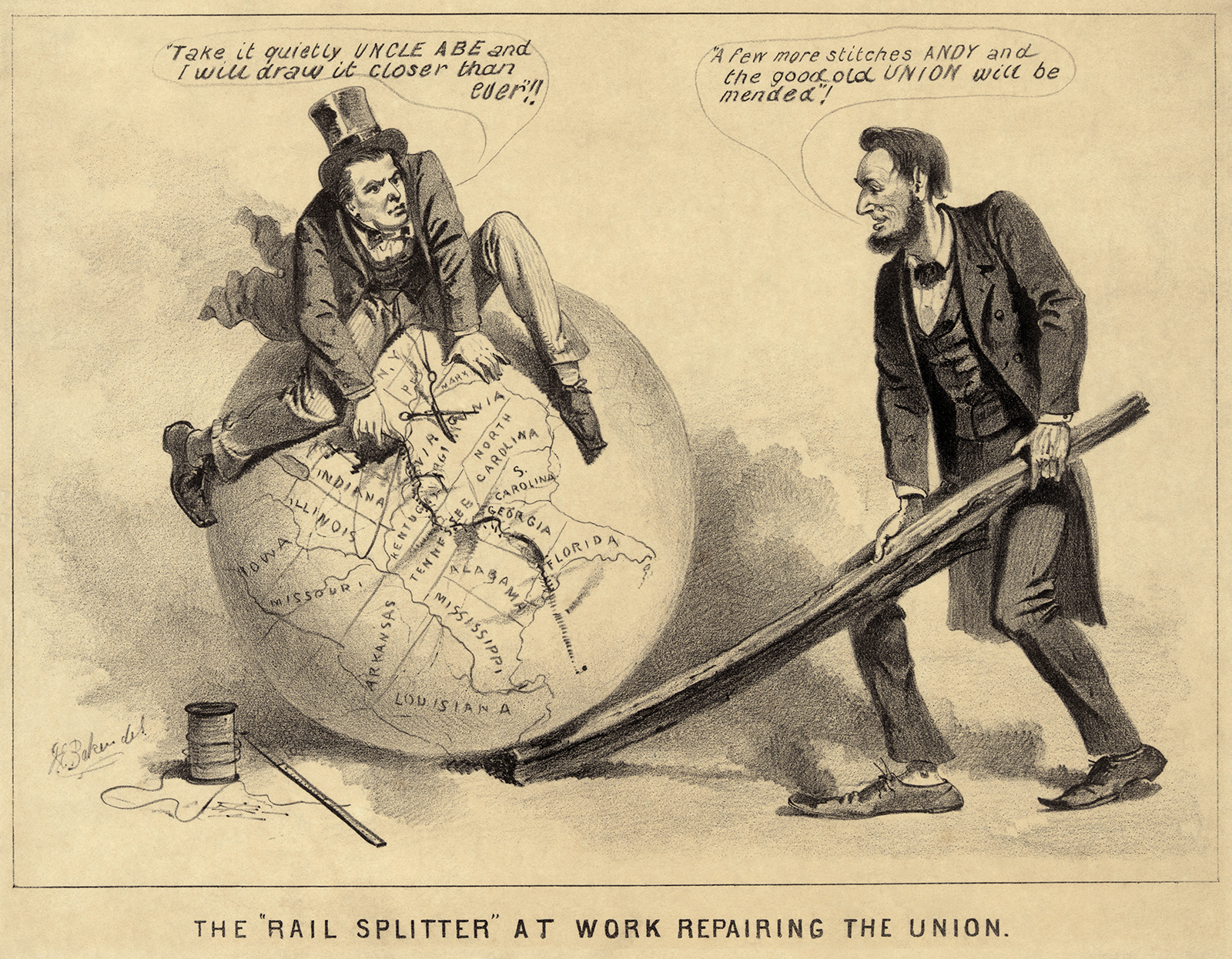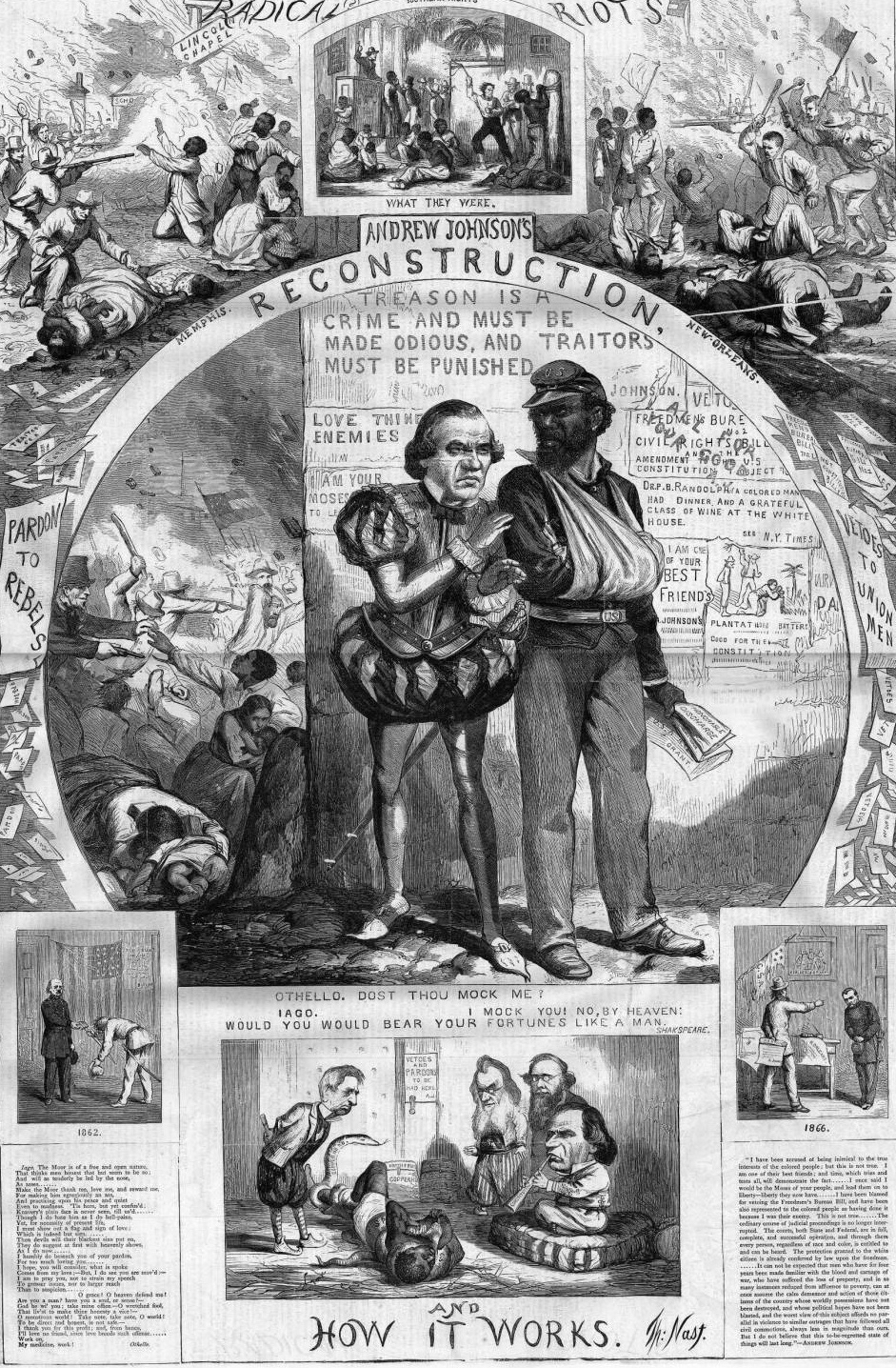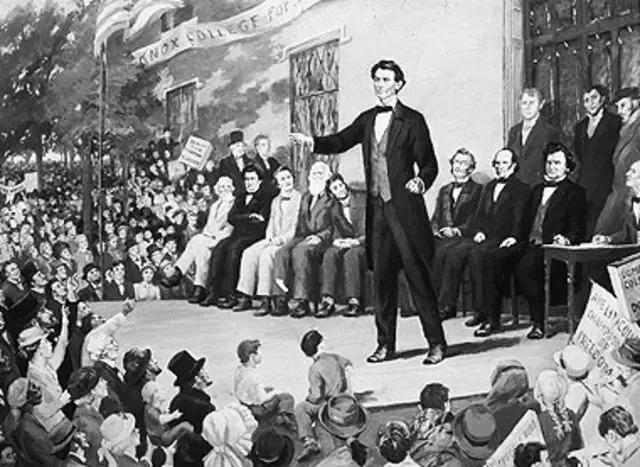Reconstruction Comes To An End
After 1867, an increasing number of southern whites turned to violence in response to the revolutionary changes of Radical Reconstruction. The Ku Klux Klan and other white supremacist organizations targeted local Republican leaders, white and Black, and other African Americans who challenged white authority. Though federal legislation passed during the administration of President Ulysses S. Grant in 1871 took aim at the Klan and others who attempted to interfere with Black suffrage and other political rights, white supremacy gradually reasserted its hold on the South after the early 1870s as support for Reconstruction waned.
Racism was still a potent force in both South and North, and Republicans became more conservative and less egalitarian as the decade continued. In 1874after an economic depression plunged much of the South into povertythe Democratic Party won control of the House of Representatives for the first time since the Civil War.
READ MORE: How the 1876 Election Effectively Ended Reconstruction
The Compromise of 1876 marked the end of Reconstruction as a distinct period, but the struggle to deal with the revolution ushered in by slaverys eradication would continue in the South and elsewhere long after that date. A century later, the legacy of Reconstruction would be revived during the civil rights movement of the 1960s, as African Americans fought for the political, economic and social equality that had long been denied them.
How True Radical Was Radical Reconstruction
How truly radical was radical Reconstruction? After northern voters rejected Johnsons policies in the congressional elections in late 1866, Republicans in Congress took firm hold of Reconstruction in the South. Blacks won election to southern state governments and even to the U.S. Congress during this period.
The Radical Republicans Take Control
Northern voters spoke clearly in the Congressional election of 1866. Radical Republicans won over two-thirds of the seats in the House of Representatives and the Senate. They now had the power to override Johnsons vetoes and pass the Civil Rights Act and the bill to extend the Freedmens Bureau, and they did so immediately. Congress had now taken charge of the Souths reconstruction.
Dont Miss: What Cities Are Run By Republicans
Don’t Miss: Did Republicans And Democrats Switch Names
Or Use Our Power Search Technology To Lookfor More Unique Definitions From Across The Web
What does RADICAL REPUBLICAN mean?
- Radical Republican
- The Radical Republicans were a faction of American politicians within the Republican Party from about 1854 until the end of Reconstruction in 1877. They called themselves “Radicals” and were opposed during the war by the Moderate Republicans, by the Conservative Republicans, and by the pro-slavery Democratic Party. After the war, the Radicals were opposed by self-styled “conservatives” and “liberals”. Radicals strongly opposed slavery during the war and after the war distrusted ex-Confederates, demanding harsh policies for the former rebels, and emphasizing civil rights and voting rights for freedmen.During the war, Radical Republicans often opposed Lincoln in terms of selection of generals and his efforts to bring states back into the Union. The Radicals passed their own reconstruction plan through Congress in 1864, but Lincoln vetoed it and was putting his own policies in effect when he was assassinated in 1865. Radicals pushed for the uncompensated abolition of slavery, while Lincoln wanted to pay slave owners who were loyal to the union. After the war, the Radicals demanded civil rights for freedmen, such as measures ensuring suffrage.
Who Were Radical Republicans And What Were Their Goals

Radical Republicans believed that African Americans deserved immediate freedom from bondage and should receive the same rights as whites. Radical Republicans favored granting civil rights to African Americans for various reasons. Some radicals truly believed that African Americans were equals to the whites.
You May Like: Why Are Republicans So Afraid Of Trump
Radical Republicans Of Reconstruction
Some readers may wonder if the American people supported all of this radicalism. They had, after all, handed the Radicals a substantial off-year victory in 1866. Howard Beale, in his 400-page study of that election, wrote that such a conclusion would not be justified. There were, as Beale explains, many issues at stake in the 1866 election.
Likewise, the Radicals had spread the idea that if Johnsons lenient Reconstruction plan were allowed to stand, disloyal Southern congressmen would vote to repudiate the federal debtleaving U.S. bondholders with only worthless paperand may even vote to honor the Confederate debt. That there was not the slightest prospect that such a thing would happen did nothing to prevent Radicals from using it to scare voters. Beale concludes from his study of the 1866 campaign that the Radicals forced their program upon the South by an evasion of issues and the clever use of propaganda in an election where a majority of the voters would have supported Johnsons policy had they been given a chance to express their preference on an issue squarely faced.
Cite This Article
What Do Radical Republicans Want
Radical Republicans believed that African Americans deserved immediate freedom from bondage and should receive the same rights as whites. Radical Republicans favored granting civil rights to African Americans for various reasons. Some radicals truly believed that African Americans were equals to the whites.
Recommended Reading: My Patriot Supply 72 Hour Kit Review
Read A Brief Summary Of This Topic
Radical Republican, during and after the American Civil War, a member of the Republican Party committed to emancipation of the slaves and later to the equal treatment and enfranchisement of the freed blacks.
The Republican Party at its formation during the 1850s was a coalition of Northern altruists, industrialists, former Whigs, practical politicians, etc. While not publicly committed to abolition of slavery prior to the Civil War, the party nonetheless attracted the most zealous antislavery advocates. While Pres. Abraham Lincoln declared restoration of the Union to be his aim during the Civil War, the antislavery advocates in Congress pressed for emancipation as a stated war aim as well.
In December 1861, frustrated at the poor showing of the Union Army and the lack of progress toward emancipation, the Radicals formed the Joint Committee on the Conduct of the War. They agitated for the dismissal of Gen. George B. McClellan, and they favoured the enlistment of black troops. Angry at Lincoln for his reluctance to move toward speedy abolition, they broke with him completely over Reconstruction policy.
From Watergate To A New Millennium
From 1972 to 1988 the Democrats lost four of five presidential elections. In 1972 the party nominated antiwar candidate George S. McGovern, who lost to Nixon in one of the biggest landslides in U.S. electoral history. Two years later the Watergate scandal forced Nixons resignation, enabling Jimmy Carter, then the Democratic governor of Georgia, to defeat Gerald R. Ford, Nixons successor, in 1976. Although Carter orchestrated the Camp David Accords between Egypt and Israel, his presidency was plagued by a sluggish economy and by the crisis over the kidnapping and prolonged captivity of U.S. diplomats in Iran following the Islamic revolution there in 1979. Carter was defeated in 1980 by conservative Republican Ronald W. Reagan, who was easily reelected in 1984 against Carters vice president, Walter F. Mondale. Mondales running mate, Geraldine A. Ferraro, was the first female candidate on a major-party ticket. Reagans vice president, George Bush, defeated Massachusetts Governor Michael S. Dukakis in 1988. Despite its losses in the presidential elections of the 1970s and 80s, the Democratic Party continued to control both houses of Congress for most of the period .
You May Like: Fact Check Republican Health Care Plan
Battle Of Fort Sumter
The American Civil War began on April 12, 1861, when Confederate forces opened fire on the Union-held Fort Sumter. Fort Sumter is located in the middle of the harbor of Charleston, South Carolina. Its status had been contentious for months. Outgoing President Buchanan had dithered in reinforcing the Union garrison in the harbor, which was under command of Major Robert Anderson. Anderson took matters into his own hands and on December 26, 1860, under the cover of darkness, sailed the garrison from the poorly placed Fort Moultrie to the stalwart island Fort Sumter. Anderson’s actions catapulted him to hero status in the North. An attempt to resupply the fort on January 9, 1861 failed and nearly started the war then and there. But an informal truce held. On March 5, the newly sworn in Lincoln was informed that the Fort was running low on supplies.
Thus, at 4:30 am on April 12, Confederate forces fired the first of 4,000 shells at the Fort it fell the next day. The loss of Fort Sumter lit a patriotic fire under the North. On April 15, Lincoln called on the states to field 75,000 volunteer troops for 90 days impassioned Union states met the quotas quickly. On May 3, 1861, Lincoln called for an additional 42,000 volunteers for a period of three years. Shortly after this, Virginia, Tennessee, Arkansas, and North Carolina seceded and joined the Confederacy. To reward Virginia, the Confederate capital was moved to Richmond.
The Obama Years And The Rise Of The Tea Party: 20082016
Following the 2008 elections, the Republican Party, reeling from the loss of the presidency, Congress and key state governorships, was fractured and leaderless.Michael Steele became the first black chairman of the Republican National Committee, but was a poor fundraiser and was replaced after numerous gaffes and missteps. Republicans suffered an additional loss in the Senate in April 2009, when Arlen Specter switched to the Democratic Party, depriving the GOP of a critical 41st vote to block legislation in the Senate. The seating of Al Frankenseveral months later effectively handed the Democrats a filibuster-proof majority, but it was short-lived as the GOP took back its 41st vote when Scott Brown won a special election in Massachusetts in early 2010.
Republicans won back control of the House of Representatives in the , with a net gain of 63 seats, the largest gain for either party since 1948. The GOP also picked up six seats in the Senate, falling short of retaking control in that chamber, and posted additional gains in state governor and legislative races. Boehner became Speaker of the House while McConnell remained as the Senate Minority Leader. In an interview with National Journal magazine about congressional Republican priorities, McConnell explained that the single most important thing we want to achieve is for Obama to be a one-term president.
Also Check: How Many Americans Are Registered Republicans
Read Also: Us Patriot Tactical Oak Grove Ky
What Were Abraham Lincolns Plans For The South
In December 1863 Lincoln announced a general plan for the orderly Reconstruction of the Southern states, promising to recognize the government of any state that pledged to support the Constitution and the Union and to emancipate enslaved persons if it was backed by at least 10 percent of the number of voters in the
What Did Radical Republicans Want But So

Radical Republicans believed that African Americans deserved immediate freedom from bondage and should receive the same rights as whites. Radical Republicans favored granting civil rights to African Americans for various reasons. Some radicals truly believed that African Americans were equals to the whites.
Read Also: Steve Miller For Judge Republican
How Is The Democratic Party Different From The Republican Party
Democrats are generally considered liberal, while Republicans are seen as conservative. The Democratic Party typically supports a larger government role in economic issues, backing regulations and social welfare programs. The Republicans, however, typically want a smaller government that is less involved in the economy. This contrary view on the size of government is reflected in their positions on taxesDemocrats favour a progressive tax to finance governments expanded role, while Republicans support lower taxes for all. However, Republicans do support a large budget for the military, and they often aggressively pursue U.S. national security interests, even if that means acting unilaterally. Democrats, however, prefer multilateralism. On social issues, Democrats seek greater freedoms, while Republicans follow more traditional values, supporting government intervention in such matters. For example, Democrats generally back abortion rights, while Republicans dont. In terms of geography, Democrats typically dominate in large cities, while Republicans are especially popular in rural areas.
You May Like: Trump 1998 People Magazine Quote
What Is The Radical Republican Plan
The Radical Republicans’ reconstruction offered all kinds of new opportunities to African-American people, including the vote , property ownership, education, legal rights, and even the possibility of holding political office. By the beginning of 1868, about 700,000 African Americans were registered voters.
Read Also: Patriot Mobile Coverage Vs Verizon
What Was The Radical Plan Of Reconstruction
After the election of November 6, 1866, Congress imposes its own Reconstruction policies, referred to by historians as Radical Reconstruction. This re-empowers the Freedmans Bureau and sets reform efforts in motion that will lead to the 14th and 15th Amendments, which, respectively, grant citizenship to all
Recommended Reading: Should Republicans Vote On Super Tuesday
What Were The Social And Political Effects Of Radical Reconstruction
What were the social and political effects of Radical Reconstruction in the South? Southern governments were then formed The newly formed southern governments established public schools, but they were still segregated and did not receive enough money to assist them. Black literacy rates improved but not drastically.
You May Like: 2017 Jeep Patriot 4×4 For Sale
Who Are The Radicals In The Civil War
The Radicals were the faction who led the fight against the War Democrat Southern Unionist Andrew Johnson .
Who was the Radical leader of Military Reconstruction?
If anything gives Military Reconstruction its name, it is the policies led by the Radicals. The Radicals were the faction who led the fight against the War Democrat Southern Unionist Andrew Johnson .
Which Of The Following Measures Did Radical Republicans Support
The Radical Republicans most important measures were contained in the Reconstruction Acts of 1867 and 1868, which placed the Southern states under military government and required universal manhood suffrage. Despite the Radical program, however, white control over Southern state governments was gradually restored.
Don’t Miss: 2009 Jeep Patriot Transmission Fluid
Why Did The Radical Republican Reconstruction Plan Fail
The Radical Republicans opposed Lincolns plan because they thought it too lenient toward the South. Radical Republicans believed that Lincolns plan for Reconstruction was not harsh enough because, from their point of view, the South was guilty of starting the war and deserved to be punished as such.
Making Black Demands Known

For now, the only leverage blacks could apply in making their demands was the threat of the continued presence of federal troops and agentsespecially of the Freedmens Bureau, which whites particularly hatedin the South. These demands included, first and foremost, the right to vote, to serve on juries, and to obtain education. Although economic issuesparticularly that of landownership, and whether the federal government would compensate the former slaves with free landwere of great concern to blacks, they generally avoided making demands in this area because they did not want to alarm whites. Their statements were sprinkled with the references to such popular nineteenth-century values as hard work, honesty, thrift, neatness, morality, and Christianity. They asked for civil and political rights but not for social equality with whites, emphasizing that they did not wish to socialize with whites if whites did not desire such contact.
You May Like: How Many Republicans Need To Vote Against Kavanaugh
Don’t Miss: What Did Republicans Gain From The Compromise Of 1877
What Is The Difference Between Moderate And Radical Republicans
Moderates did not actively support black voting rights and the distribution of confiscated lands to the freedmen, while Radicals did. Radical Republicans, on the other hand, hoped that reconstruction could achieve black equality, free land distribution to former slaves, and voting rights for African Americans.
General Features Of The War
The Civil War was a contest marked by the ferocity and frequency of battle. Over four years, 237 named battles were fought, as were many more minor actions and skirmishes, which were often characterized by their bitter intensity and high casualties. In his book The American Civil War, British historian John Keegan writes that “The American Civil War was to prove one of the most ferocious wars ever fought”. In many cases, without geographic objectives, the only target for each side was the enemy’s soldier.
Read Also: Who Were The Radical Republicans And What Did They Believe
The New Deal Coalition
The countrys third critical election, in 1932, took place in the wake of the stock market crash of 1929 and in the midst of the Great Depression. Led by Franklin D. Roosevelt, the Democrats not only regained the presidency but also replaced the Republicans as the majority party throughout the countryin the North as well as the South. Through his political skills and his sweeping New Deal social programs, such as social security and the statutory minimum wage, Roosevelt forged a broad coalitionincluding small farmers, Northern city dwellers, organized labour, European immigrants, liberals, intellectuals, and reformersthat enabled the Democratic Party to retain the presidency until 1952 and to control both houses of Congress for most of the period from the 1930s to the mid-1990s. Roosevelt was reelected in 1936, 1940, and 1944 he was the only president to be elected to more than two terms. Upon his death in 1945 he was succeeded by his vice president, Harry S. Truman, who was narrowly elected in 1948.
